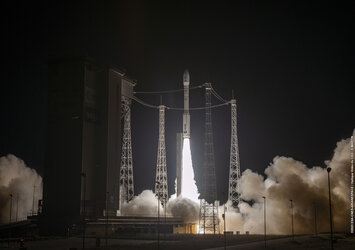Accept all cookies Accept only essential cookies See our Cookie Notice

About ESA
The European Space Agency (ESA) is Europe’s gateway to space. Its mission is to shape the development of Europe’s space capability and ensure that investment in space continues to deliver benefits to the citizens of Europe and the world.
Highlights
ESA - United space in Europe
This is ESA ESA facts Member States & Cooperating States Funding Director General Top management For Member State Delegations European vision European Space Policy ESA & EU Space Councils Responsibility & Sustainability Annual Report Calendar of meetings Corporate newsEstablishments & sites
ESA Headquarters ESA ESTEC ESA ESOC ESA ESRIN ESA EAC ESA ESAC Europe's Spaceport ESA ESEC ESA ECSAT Brussels Office Washington OfficeWorking with ESA
Business with ESA ESA Commercialisation Gateway Law at ESA Careers Cyber resilience at ESA IT at ESA Newsroom Partnerships Merchandising Licence Education Open Space Innovation Platform Integrity and Reporting Administrative Tribunal Health and SafetyMore about ESA
History ESA Historical Archives Exhibitions Publications Art & Culture ESA Merchandise Kids Diversity ESA Brand CentreLatest
Space in Member States
Find out more about space activities in our 23 Member States, and understand how ESA works together with their national agencies, institutions and organisations.
Science & Exploration
Exploring our Solar System and unlocking the secrets of the Universe
Go to topicAstronauts
Missions
Juice Euclid Webb Solar Orbiter BepiColombo Gaia ExoMars Cheops Exoplanet missions More missionsActivities
International Space Station Orion service module Gateway Concordia Caves & Pangaea BenefitsLatest
Space Safety
Protecting life and infrastructure on Earth and in orbit
Go to topicAsteroids
Asteroids and Planetary Defence Asteroid danger explained Flyeye telescope: asteroid detection Hera mission: asteroid deflection Near-Earth Object Coordination CentreSpace junk
About space debris Space debris by the numbers Space Environment Report In space refuelling, refurbishing and removingSafety from space
Clean Space ecodesign Zero Debris Technologies Space for Earth Supporting Sustainable DevelopmentSpace weather
Space weather and its hazards ESA Vigil: providing solar warning ESA Space Weather Service NetworkLatest
Applications
Using space to benefit citizens and meet future challenges on Earth
Go to topicObserving the Earth
Observing the Earth Future EO Copernicus Meteorology Space for our climate Satellite missionsCommercialisation
ESA Commercialisation Gateway Open Space Innovation Platform Business Incubation ESA Space SolutionsLatest
Enabling & Support
Making space accessible and developing the technologies for the future
Go to topicBuilding missions
Space Engineering and Technology Test centre Laboratories Concurrent Design Facility Preparing for the future Shaping the Future Discovery and Preparation Advanced Concepts TeamSpace transportation
Space Transportation Ariane Vega Space Rider Future space transportation Boost! Europe's Spaceport Launches from Europe's Spaceport from 2012Latest

Orbital Matter and RIDE!
Thank you for liking
You have already liked this page, you can only like it once!
Chloé Pasquier, Mission Manager at RIDE! space joins co-founder of Orbital Matter, Robert Ihnatisin and Arianespace’s Jerome Germain, at Arianespace’s facilities near Paris, France.
The Replicator mission, from Warsaw, Poland, and Berlin, Germany, based startup Orbital Matter, will launch on Ariane 6 to demonstrate a new 3D printing technology in orbit, potentially opening the door to new space structures that wouldn’t have been possible otherwise, made using fewer resources.
Their new method of 3D printing has been developed to work directly in a vacuum and under microgravity, without requiring heat to be generated during manufacturing. As there is no atmosphere to cool down parts via convection cooling, like blowing on a spoonful of hot soup, it takes a long time – months – for parts to cool down just through irradiation (simply waiting for the soup to lose heat). Orbital Matter’s process prints without heat, making it much faster to build structures in a vacuum.
3D printing, or ‘additive manufacturing’, was first tested in space on the International Space Station in 2014 and has proven useful for the on-demand manufacturing of tools and spare parts. So far, no 3D printing technology has been shown to work in the significantly harsher exposed conditions outside of the Space Station, in ‘open’ space, limiting its use.
Manufacturing directly in space means large structures could in principle be built with fewer materials, as they don’t need to withstand the rigours of launch. This could mean large space-based solar power plants, communication antennas, larger telescopes for science missions and even larger space stations could all be built in orbit. Such structures could provide real benefits, from making electricity cheaper, greener and more accessible for remote areas to reducing the cost of communication and increasing access to it, furthering our general knowledge of the Universe and making space tourism cheaper and more accessible.
Orbital Matter has already demonstrated that their 3D printing technology works in a vacuum on Earth, but with the Ariane 6 first launch, they will perform their first in-space demonstration: their three-unit CubeSat (10x10x30 cm) will print a 50 cm-long beam while at an altitude of 580 km, out of a custom polymer material.
-
CREDIT
ESA -
LICENCE
ESA Standard Licence














 Germany
Germany
 Austria
Austria
 Belgium
Belgium
 Denmark
Denmark
 Spain
Spain
 Estonia
Estonia
 Finland
Finland
 France
France
 Greece
Greece
 Hungary
Hungary
 Ireland
Ireland
 Italy
Italy
 Luxembourg
Luxembourg
 Norway
Norway
 The Netherlands
The Netherlands
 Poland
Poland
 Portugal
Portugal
 Czechia
Czechia
 Romania
Romania
 United Kingdom
United Kingdom
 Slovenia
Slovenia
 Sweden
Sweden
 Switzerland
Switzerland




























